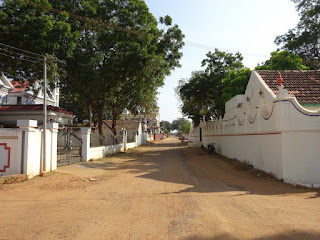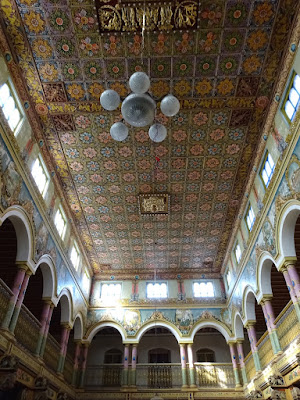Kanadukathan Located 10 km from Karaikudi, Tamil Nadu. The Chettinad Palace was designed and constructed by Dr.Annamalai Chettiyar, founder of the Indian Bank and the Annamalai University in Chidambaram. Most of the construction materials, decorative items and furnishings used to construct Chettinad Palace were imported from East Asian countries and Europe. All the mansions have lovely teak, marble or granite pillars supporting a spacious verandah.
Chettinad heritage – Chettinad means country of the Chettiars. The Chettiars belong to a lineage of wealthy traders and financiers who made their fortunes by extending their business to the whole of Southeast Asia, particularly during the 19th century, when they were at the peak of their economic power.
|
 |
The other highlights of these homes are the intricate woodwork on doors depicting Lakshmi, the goddess of wealth who presides over these homes. And then the smooth, still gleaming plaster on the walls made of a ground mixture of egg white, lime, powdered shells and a local fruit.
Status symbols
Chettiars belong to a trading community, with ties once extending as far as Singapore and Malaysia. They were known as bankers and moneylenders to the British Raj and flourished under their rule. Chettiars invested their wealth in their hometowns, building large mansions. The larger the mansion, the higher the status. And they brought in the best from everywhere in the world: glass from Murano, teak from Burma, chandeliers from Belgium and tiles from Athangudi. They threw in some Victorian furniture and Art Deco influences to the mix to form arresting architectural masterpieces.
Chettinad is rich in cultural heritage, art and architecture, and is well known for its houses, embellished with marble and Burma teak, wide courtyards, spacious rooms, and for its 18th century mansions.
Local legend tells that their walls used to be polished with a paste made out of eggwhites to give a smooth texture.
The construction material, decorative items and furnishings were mostly imported from East Asian countries and Europe. The marble was brought from Italy, chandeliers and teak from Burma, crockery from Indonesia, crystals from Europe and wall-to-wall mirrors from Belgium. The woodwork and stonework was inspired that of the houses in France and other European destinations.
These handmade tiles, made from local sand, are a visual delight. Walk into any one of the several home factories in Athangudi to watch the workmen fill the moulds with the bright paints mixed with a little cement. These tiles, which stay new and glossy for decades. visitors can see how a basic stencil, and clever use of colours and techniques create stunning floor tiles in floral, geometric, and paisley patterns. Tile-making skills are passed on from father to son and the superiority of these products is credited to the high quality of local soil and water.
I am still unable to digest the fact that the entire mansion was owned and managed by a single family.


























































